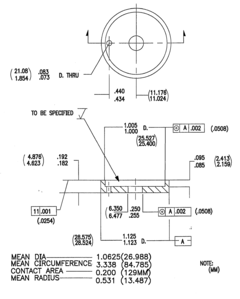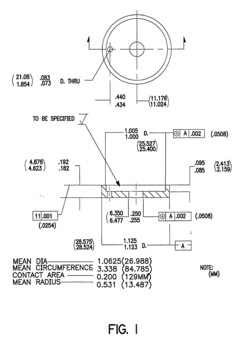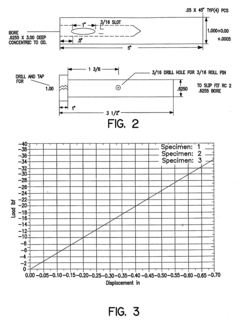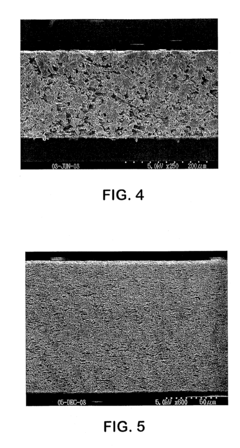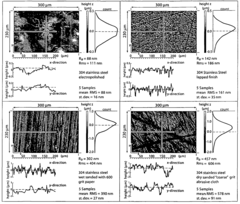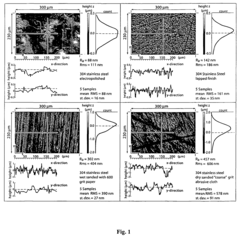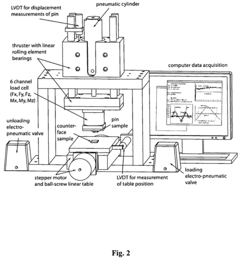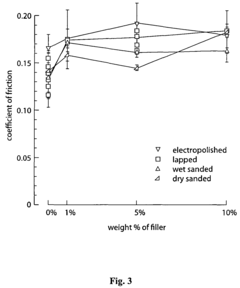PTFE: Advancements in Wear‑Resistant Materials
JUN 27, 20259 MIN READ
Generate Your Research Report Instantly with AI Agent
Patsnap Eureka helps you evaluate technical feasibility & market potential.
PTFE Evolution and Objectives
Polytetrafluoroethylene (PTFE), commonly known as Teflon, has been a revolutionary material in the field of wear-resistant applications since its accidental discovery by Roy Plunkett in 1938. The evolution of PTFE has been marked by continuous advancements in its properties and applications, driven by the increasing demand for high-performance materials in various industries.
Initially, PTFE was primarily used in military and aerospace applications due to its unique properties, including chemical inertness, low friction coefficient, and high temperature resistance. As manufacturing processes improved, PTFE found its way into consumer products, most notably non-stick cookware in the 1960s. This marked the beginning of PTFE's widespread adoption across multiple sectors.
The development of PTFE has been characterized by ongoing efforts to enhance its wear resistance, thermal stability, and mechanical properties. Researchers have focused on modifying the molecular structure of PTFE and creating composites to overcome its inherent limitations, such as poor wear resistance under high loads and creep tendency.
One significant trend in PTFE evolution has been the development of micro and nanostructured PTFE materials. These advancements have led to improved wear resistance and lower friction coefficients, expanding PTFE's applicability in demanding environments such as automotive and industrial machinery.
The objectives of current PTFE research and development are multifaceted. Primarily, there is a strong focus on further improving wear resistance without compromising the material's other beneficial properties. This includes developing new composite materials that incorporate reinforcing agents like carbon fibers, glass fibers, or nanoparticles to enhance mechanical strength and wear resistance.
Another key objective is to expand PTFE's temperature range capabilities. While PTFE already performs well in a wide temperature range, there is a push to develop formulations that can withstand even more extreme conditions, both at high and low temperatures. This is particularly important for aerospace and deep-sea applications.
Sustainability has also become a crucial factor in PTFE evolution. Researchers are exploring ways to make PTFE production more environmentally friendly and to improve its recyclability. This includes developing bio-based alternatives and investigating methods for efficient PTFE recycling and reuse.
The future of PTFE technology is likely to see a convergence with other advanced materials and manufacturing techniques. For instance, the integration of PTFE with smart materials or its use in additive manufacturing processes presents exciting possibilities for creating highly customized, high-performance components.
As we look ahead, the evolution of PTFE is expected to continue its trajectory towards more specialized, high-performance applications. The objectives will likely include developing PTFE-based materials with self-healing properties, enhanced electrical conductivity for specific applications, and even more extreme wear resistance for use in harsh environments.
Initially, PTFE was primarily used in military and aerospace applications due to its unique properties, including chemical inertness, low friction coefficient, and high temperature resistance. As manufacturing processes improved, PTFE found its way into consumer products, most notably non-stick cookware in the 1960s. This marked the beginning of PTFE's widespread adoption across multiple sectors.
The development of PTFE has been characterized by ongoing efforts to enhance its wear resistance, thermal stability, and mechanical properties. Researchers have focused on modifying the molecular structure of PTFE and creating composites to overcome its inherent limitations, such as poor wear resistance under high loads and creep tendency.
One significant trend in PTFE evolution has been the development of micro and nanostructured PTFE materials. These advancements have led to improved wear resistance and lower friction coefficients, expanding PTFE's applicability in demanding environments such as automotive and industrial machinery.
The objectives of current PTFE research and development are multifaceted. Primarily, there is a strong focus on further improving wear resistance without compromising the material's other beneficial properties. This includes developing new composite materials that incorporate reinforcing agents like carbon fibers, glass fibers, or nanoparticles to enhance mechanical strength and wear resistance.
Another key objective is to expand PTFE's temperature range capabilities. While PTFE already performs well in a wide temperature range, there is a push to develop formulations that can withstand even more extreme conditions, both at high and low temperatures. This is particularly important for aerospace and deep-sea applications.
Sustainability has also become a crucial factor in PTFE evolution. Researchers are exploring ways to make PTFE production more environmentally friendly and to improve its recyclability. This includes developing bio-based alternatives and investigating methods for efficient PTFE recycling and reuse.
The future of PTFE technology is likely to see a convergence with other advanced materials and manufacturing techniques. For instance, the integration of PTFE with smart materials or its use in additive manufacturing processes presents exciting possibilities for creating highly customized, high-performance components.
As we look ahead, the evolution of PTFE is expected to continue its trajectory towards more specialized, high-performance applications. The objectives will likely include developing PTFE-based materials with self-healing properties, enhanced electrical conductivity for specific applications, and even more extreme wear resistance for use in harsh environments.
Market Demand Analysis
The market demand for PTFE (Polytetrafluoroethylene) as a wear-resistant material has been steadily increasing across various industries due to its unique properties and versatile applications. The global PTFE market size was valued at USD 3.48 billion in 2020 and is projected to grow at a compound annual growth rate (CAGR) of 5.7% from 2021 to 2028.
The automotive sector represents a significant driver for PTFE demand, particularly in applications such as seals, gaskets, and bearings. As vehicle manufacturers strive for improved fuel efficiency and reduced emissions, the lightweight and low-friction properties of PTFE make it an ideal material for various automotive components. The growing electric vehicle market further amplifies this demand, as PTFE is used in battery systems and electrical insulation.
In the aerospace industry, PTFE's high temperature resistance and chemical inertness make it invaluable for aircraft components, including hydraulic systems, fuel lines, and seals. With the increasing number of commercial aircraft deliveries and the expansion of the space exploration sector, the demand for PTFE in aerospace applications is expected to rise significantly.
The medical industry is another key market for PTFE, driven by its biocompatibility and non-stick properties. PTFE is widely used in medical devices, implants, and surgical instruments. The aging population and increasing prevalence of chronic diseases contribute to the growing demand for PTFE-based medical products.
Industrial machinery and equipment manufacturers are increasingly adopting PTFE for various applications, including bearings, seals, and conveyor belts. The material's ability to withstand harsh chemical environments and high temperatures makes it ideal for use in chemical processing plants, oil refineries, and other industrial settings.
The electronics industry is also a significant consumer of PTFE, particularly in the production of printed circuit boards (PCBs) and semiconductor manufacturing equipment. As the demand for smaller, more powerful electronic devices continues to grow, so does the need for PTFE in this sector.
Emerging applications in renewable energy technologies, such as wind turbines and solar panels, are creating new opportunities for PTFE. The material's weather resistance and durability make it suitable for use in outdoor energy generation equipment.
Geographically, Asia-Pacific is expected to be the fastest-growing market for PTFE, driven by rapid industrialization, increasing automotive production, and growing electronics manufacturing in countries like China and India. North America and Europe remain significant markets, with a focus on high-performance applications in aerospace and medical industries.
The automotive sector represents a significant driver for PTFE demand, particularly in applications such as seals, gaskets, and bearings. As vehicle manufacturers strive for improved fuel efficiency and reduced emissions, the lightweight and low-friction properties of PTFE make it an ideal material for various automotive components. The growing electric vehicle market further amplifies this demand, as PTFE is used in battery systems and electrical insulation.
In the aerospace industry, PTFE's high temperature resistance and chemical inertness make it invaluable for aircraft components, including hydraulic systems, fuel lines, and seals. With the increasing number of commercial aircraft deliveries and the expansion of the space exploration sector, the demand for PTFE in aerospace applications is expected to rise significantly.
The medical industry is another key market for PTFE, driven by its biocompatibility and non-stick properties. PTFE is widely used in medical devices, implants, and surgical instruments. The aging population and increasing prevalence of chronic diseases contribute to the growing demand for PTFE-based medical products.
Industrial machinery and equipment manufacturers are increasingly adopting PTFE for various applications, including bearings, seals, and conveyor belts. The material's ability to withstand harsh chemical environments and high temperatures makes it ideal for use in chemical processing plants, oil refineries, and other industrial settings.
The electronics industry is also a significant consumer of PTFE, particularly in the production of printed circuit boards (PCBs) and semiconductor manufacturing equipment. As the demand for smaller, more powerful electronic devices continues to grow, so does the need for PTFE in this sector.
Emerging applications in renewable energy technologies, such as wind turbines and solar panels, are creating new opportunities for PTFE. The material's weather resistance and durability make it suitable for use in outdoor energy generation equipment.
Geographically, Asia-Pacific is expected to be the fastest-growing market for PTFE, driven by rapid industrialization, increasing automotive production, and growing electronics manufacturing in countries like China and India. North America and Europe remain significant markets, with a focus on high-performance applications in aerospace and medical industries.
PTFE Challenges and Limitations
Despite its numerous advantages, PTFE faces several challenges and limitations that hinder its widespread adoption in certain applications. One of the primary concerns is its poor wear resistance under high loads and sliding speeds. While PTFE exhibits excellent low friction properties, it tends to wear quickly when subjected to intense mechanical stress, limiting its longevity in high-wear environments.
Another significant limitation is PTFE's relatively low load-bearing capacity compared to other engineering plastics. This restricts its use in applications requiring high mechanical strength, particularly in structural components or heavy-duty machinery parts. The material's inherent softness, while beneficial for some applications, becomes a drawback in scenarios demanding rigidity and dimensional stability.
PTFE's poor thermal conductivity poses challenges in heat-sensitive applications. In situations where heat dissipation is crucial, such as in certain electronic components or thermal management systems, PTFE's insulating properties can be a disadvantage. This limitation often necessitates the use of alternative materials or complex design modifications to address thermal management issues.
The material's susceptibility to cold flow, also known as creep, presents another challenge. Under sustained loads, PTFE tends to deform permanently over time, which can lead to loss of sealing properties in gaskets and other precision components. This characteristic limits PTFE's use in applications requiring long-term dimensional stability under constant stress.
PTFE's non-stick properties, while advantageous in many scenarios, can be problematic when adhesion is required. This makes it challenging to bond PTFE to other materials, complicating the design and manufacturing processes for composite structures or multi-material assemblies. Special surface treatments or adhesive systems are often necessary to overcome this limitation.
The high cost of PTFE production and processing is another significant barrier to its wider adoption. The complex manufacturing process, involving specialized equipment and techniques, contributes to the material's relatively high price point compared to other plastics. This economic factor often restricts PTFE's use to high-value applications where its unique properties justify the increased cost.
Environmental concerns also pose challenges for PTFE. The production of PTFE historically involved the use of perfluorooctanoic acid (PFOA), a persistent environmental pollutant. While many manufacturers have phased out PFOA, concerns about the environmental impact of fluoropolymers persist, leading to increased scrutiny and potential regulatory challenges in some regions.
Another significant limitation is PTFE's relatively low load-bearing capacity compared to other engineering plastics. This restricts its use in applications requiring high mechanical strength, particularly in structural components or heavy-duty machinery parts. The material's inherent softness, while beneficial for some applications, becomes a drawback in scenarios demanding rigidity and dimensional stability.
PTFE's poor thermal conductivity poses challenges in heat-sensitive applications. In situations where heat dissipation is crucial, such as in certain electronic components or thermal management systems, PTFE's insulating properties can be a disadvantage. This limitation often necessitates the use of alternative materials or complex design modifications to address thermal management issues.
The material's susceptibility to cold flow, also known as creep, presents another challenge. Under sustained loads, PTFE tends to deform permanently over time, which can lead to loss of sealing properties in gaskets and other precision components. This characteristic limits PTFE's use in applications requiring long-term dimensional stability under constant stress.
PTFE's non-stick properties, while advantageous in many scenarios, can be problematic when adhesion is required. This makes it challenging to bond PTFE to other materials, complicating the design and manufacturing processes for composite structures or multi-material assemblies. Special surface treatments or adhesive systems are often necessary to overcome this limitation.
The high cost of PTFE production and processing is another significant barrier to its wider adoption. The complex manufacturing process, involving specialized equipment and techniques, contributes to the material's relatively high price point compared to other plastics. This economic factor often restricts PTFE's use to high-value applications where its unique properties justify the increased cost.
Environmental concerns also pose challenges for PTFE. The production of PTFE historically involved the use of perfluorooctanoic acid (PFOA), a persistent environmental pollutant. While many manufacturers have phased out PFOA, concerns about the environmental impact of fluoropolymers persist, leading to increased scrutiny and potential regulatory challenges in some regions.
Current PTFE Solutions
01 PTFE composite materials for enhanced wear resistance
Incorporating various additives or fillers into PTFE to create composite materials can significantly improve its wear resistance. These additives may include carbon fibers, glass fibers, graphite, or other reinforcing materials. The resulting composites often exhibit superior mechanical properties and durability compared to pure PTFE.- PTFE composite materials for enhanced wear resistance: Incorporating various additives or fillers into PTFE to create composite materials can significantly improve its wear resistance. These additives may include carbon fibers, glass fibers, graphite, or other reinforcing materials. The resulting composites exhibit superior mechanical properties and enhanced durability in high-wear applications.
- Surface modification techniques for PTFE: Various surface modification techniques can be applied to PTFE to improve its wear resistance. These may include plasma treatment, chemical etching, or the application of specialized coatings. Such modifications can alter the surface properties of PTFE, enhancing its adhesion, friction characteristics, and overall wear performance.
- PTFE nanocomposites for wear-resistant applications: Incorporating nanoparticles or nanostructures into PTFE can lead to significant improvements in wear resistance. These nanocomposites may utilize materials such as carbon nanotubes, nanosilica, or metal oxide nanoparticles. The resulting materials often exhibit enhanced mechanical strength, thermal stability, and tribological properties.
- PTFE blends and alloys for improved wear characteristics: Blending PTFE with other polymers or creating polymer alloys can result in materials with superior wear resistance. These blends may combine the low friction properties of PTFE with the mechanical strength of other polymers, resulting in materials suitable for demanding wear applications.
- Specialized processing techniques for wear-resistant PTFE: Employing specific processing techniques during the manufacture of PTFE products can enhance their wear resistance. These may include optimized sintering processes, compression molding techniques, or the use of specialized extrusion methods. Such processes can improve the material's density, crystallinity, and overall wear performance.
02 Surface modification techniques for PTFE
Various surface modification techniques can be applied to PTFE to enhance its wear resistance. These may include plasma treatment, chemical etching, or the application of specialized coatings. Such modifications can alter the surface properties of PTFE, improving its adhesion, friction characteristics, and overall wear performance.Expand Specific Solutions03 PTFE nanocomposites for improved wear resistance
Incorporating nanoparticles or nanostructures into PTFE can lead to significant improvements in wear resistance. These nanocomposites may utilize materials such as carbon nanotubes, nanosilica, or metal nanoparticles. The nano-scale reinforcement can enhance the mechanical properties and tribological performance of PTFE.Expand Specific Solutions04 PTFE blends and alloys for wear-resistant applications
Blending PTFE with other polymers or creating polymer alloys can result in materials with improved wear resistance. These blends may combine the low friction properties of PTFE with the mechanical strength of other polymers, resulting in materials suitable for high-wear applications.Expand Specific Solutions05 Specialized processing techniques for wear-resistant PTFE
Employing specific processing techniques during the manufacture of PTFE products can enhance their wear resistance. These may include optimized sintering processes, compression molding techniques, or the use of specific heat treatments. Such processes can improve the molecular structure and overall durability of PTFE components.Expand Specific Solutions
Key PTFE Industry Players
The PTFE wear-resistant materials market is in a mature growth stage, with a global market size estimated to exceed $2 billion. The technology has reached a high level of maturity, with ongoing advancements focused on enhancing performance and expanding applications. Key players like W. L. Gore & Associates, DAIKIN INDUSTRIES, and Zhonghao Chenguang Research Institute are driving innovation in PTFE materials. Universities such as the University of Florida and Zhejiang University are contributing to fundamental research. The competitive landscape is characterized by a mix of established multinational corporations and specialized materials companies, with increasing focus on developing eco-friendly and high-performance PTFE formulations for diverse industrial applications.
W. L. Gore & Associates, Inc.
Technical Solution: W. L. Gore & Associates has developed advanced PTFE-based materials with enhanced wear resistance. Their ePTFE (expanded PTFE) technology creates a microporous structure that improves durability and performance[1]. They have introduced GORE® PTFE Fiber, which combines the chemical inertness of PTFE with high strength and abrasion resistance[2]. This fiber is used in various applications, including filtration, textiles, and industrial components. Gore has also developed GORE-TEX® with SHAKEDRY™ product technology, utilizing a thin PTFE membrane that is both highly durable and water-resistant[3]. Their continuous research focuses on optimizing the molecular structure and surface properties of PTFE to further enhance its wear resistance and longevity in demanding applications.
Strengths: Proprietary ePTFE technology, diverse product range, and strong R&D capabilities. Weaknesses: Higher cost compared to traditional materials, potential environmental concerns related to PTFE production.
DAIKIN INDUSTRIES Ltd.
Technical Solution: Daikin has made significant advancements in wear-resistant PTFE materials through their NEOFLON™ product line. They have developed a modified PTFE resin with improved wear resistance and lower friction coefficients[4]. Daikin's research focuses on optimizing the molecular weight and particle size distribution of PTFE to enhance its mechanical properties. They have introduced NEOFLON™ ETFE, a copolymer of ethylene and tetrafluoroethylene, which offers excellent wear resistance, chemical resistance, and electrical properties[5]. Daikin has also developed a unique surface treatment technology for PTFE that significantly improves its adhesion to other materials, expanding its application in composite structures[6]. Their ongoing research includes the development of nano-filled PTFE composites to further enhance wear resistance and thermal stability.
Strengths: Wide range of fluoropolymer products, strong presence in industrial and automotive sectors. Weaknesses: Dependency on fluorine-based chemistry, potential regulatory challenges in some markets.
PTFE Innovations Analysis
Low Friction, Abrasion-Resistant Bearing Materials
PatentInactiveUS20070119540A1
Innovation
- A unique composite bearing material is developed by imbibing polymer resins into porous, monolithic polytetrafluoroethylene (PTFE) structures, creating a low-friction, high-wear-resistant configuration that incorporates thermosetting or thermoplastic resins and optional fillers to enhance performance.
Inert wear resistant PTFE-based solid lubricant nanocomposite
PatentInactiveUS7790658B2
Innovation
- A PTFE-based composite material filled with irregularly shaped metal oxide nanoparticles, such as aluminum oxide, at lower weight percentages (1-10%), which provides enhanced wear resistance through mechanical interaction, reducing wear rates significantly compared to spherical particle-filled composites.
Environmental Impact of PTFE
The environmental impact of PTFE (Polytetrafluoroethylene) is a critical consideration in the advancement of wear-resistant materials. While PTFE offers exceptional properties for various applications, its production and disposal pose significant environmental challenges.
PTFE manufacturing processes involve the use of perfluorooctanoic acid (PFOA), a persistent organic pollutant. PFOA has been linked to various health and environmental issues, including cancer, thyroid disease, and ecosystem disruption. Recognizing these concerns, many countries have implemented regulations to phase out PFOA use in PTFE production. Industry leaders are actively developing alternative manufacturing methods to eliminate PFOA, such as using shorter-chain fluorinated compounds or fluorine-free alternatives.
The durability of PTFE, while beneficial for its wear-resistant properties, contributes to its environmental persistence. PTFE does not biodegrade easily, potentially remaining in the environment for hundreds of years. This longevity raises concerns about the accumulation of PTFE particles in ecosystems, particularly in aquatic environments where they can be ingested by marine life and enter the food chain.
Recycling PTFE presents another environmental challenge. The material's high melting point and chemical stability make traditional recycling methods ineffective. However, recent advancements in recycling technologies show promise. Some companies have developed processes to break down PTFE into its constituent monomers, which can then be used to produce new PTFE products. These circular economy approaches could significantly reduce the environmental footprint of PTFE production.
The wear-resistant nature of PTFE contributes to extended product lifespans, indirectly benefiting the environment by reducing the need for frequent replacements. This durability can lead to decreased resource consumption and waste generation over time. However, this benefit must be weighed against the environmental costs of PTFE production and end-of-life management.
Efforts to improve the environmental profile of PTFE include the development of bio-based alternatives and the exploration of more sustainable production methods. Some researchers are investigating the potential of fluorine-free compounds that mimic PTFE's properties while offering improved environmental compatibility. Additionally, advancements in green chemistry are driving the search for less harmful catalysts and processing aids in PTFE manufacturing.
As the demand for wear-resistant materials continues to grow, balancing the performance benefits of PTFE with its environmental impact remains a key challenge for the industry. Future advancements in PTFE technology will likely focus on enhancing its eco-friendly attributes while maintaining or improving its wear-resistant properties.
PTFE manufacturing processes involve the use of perfluorooctanoic acid (PFOA), a persistent organic pollutant. PFOA has been linked to various health and environmental issues, including cancer, thyroid disease, and ecosystem disruption. Recognizing these concerns, many countries have implemented regulations to phase out PFOA use in PTFE production. Industry leaders are actively developing alternative manufacturing methods to eliminate PFOA, such as using shorter-chain fluorinated compounds or fluorine-free alternatives.
The durability of PTFE, while beneficial for its wear-resistant properties, contributes to its environmental persistence. PTFE does not biodegrade easily, potentially remaining in the environment for hundreds of years. This longevity raises concerns about the accumulation of PTFE particles in ecosystems, particularly in aquatic environments where they can be ingested by marine life and enter the food chain.
Recycling PTFE presents another environmental challenge. The material's high melting point and chemical stability make traditional recycling methods ineffective. However, recent advancements in recycling technologies show promise. Some companies have developed processes to break down PTFE into its constituent monomers, which can then be used to produce new PTFE products. These circular economy approaches could significantly reduce the environmental footprint of PTFE production.
The wear-resistant nature of PTFE contributes to extended product lifespans, indirectly benefiting the environment by reducing the need for frequent replacements. This durability can lead to decreased resource consumption and waste generation over time. However, this benefit must be weighed against the environmental costs of PTFE production and end-of-life management.
Efforts to improve the environmental profile of PTFE include the development of bio-based alternatives and the exploration of more sustainable production methods. Some researchers are investigating the potential of fluorine-free compounds that mimic PTFE's properties while offering improved environmental compatibility. Additionally, advancements in green chemistry are driving the search for less harmful catalysts and processing aids in PTFE manufacturing.
As the demand for wear-resistant materials continues to grow, balancing the performance benefits of PTFE with its environmental impact remains a key challenge for the industry. Future advancements in PTFE technology will likely focus on enhancing its eco-friendly attributes while maintaining or improving its wear-resistant properties.
PTFE Applications Expansion
The expansion of PTFE applications has been a significant trend in recent years, driven by the material's unique properties and advancements in manufacturing techniques. PTFE's exceptional chemical resistance, low friction coefficient, and high temperature stability have led to its adoption in a wide range of industries beyond its traditional uses.
In the automotive sector, PTFE is increasingly utilized in engine components, such as piston rings and valve stem seals, to reduce friction and improve fuel efficiency. The material's self-lubricating properties make it ideal for these high-wear applications, extending the lifespan of critical engine parts.
The aerospace industry has also embraced PTFE for its lightweight and durability. It is now commonly found in aircraft hydraulic systems, fuel lines, and seals, where its resistance to extreme temperatures and chemicals is crucial. PTFE coatings on aircraft exteriors have shown promise in reducing drag and improving fuel economy.
In the medical field, PTFE's biocompatibility has led to its use in implantable devices and surgical instruments. Vascular grafts made from expanded PTFE (ePTFE) have become standard in cardiovascular surgeries, offering improved patency rates and reduced risk of infection.
The electronics industry has found new applications for PTFE in high-frequency circuit boards and cable insulation. Its excellent dielectric properties and low signal loss make it invaluable in 5G infrastructure and high-speed data transmission systems.
PTFE's expansion into the renewable energy sector is noteworthy. Solar panel manufacturers are using PTFE coatings to enhance the efficiency and longevity of photovoltaic cells, while wind turbine designers are incorporating PTFE bearings to reduce maintenance requirements and improve turbine performance.
In the food processing industry, PTFE's non-stick properties have led to its use in conveyor belts, packaging materials, and food preparation equipment. This has resulted in improved hygiene standards and reduced product waste.
The construction industry has also benefited from PTFE's properties. Architectural membranes made from PTFE-coated fiberglass are increasingly used in large-scale roofing projects, offering durability, weather resistance, and energy efficiency.
As research continues, new PTFE composites and manufacturing techniques are emerging, promising even broader applications. These include PTFE nanocomposites with enhanced wear resistance and PTFE-based self-healing materials that could revolutionize various industries.
In the automotive sector, PTFE is increasingly utilized in engine components, such as piston rings and valve stem seals, to reduce friction and improve fuel efficiency. The material's self-lubricating properties make it ideal for these high-wear applications, extending the lifespan of critical engine parts.
The aerospace industry has also embraced PTFE for its lightweight and durability. It is now commonly found in aircraft hydraulic systems, fuel lines, and seals, where its resistance to extreme temperatures and chemicals is crucial. PTFE coatings on aircraft exteriors have shown promise in reducing drag and improving fuel economy.
In the medical field, PTFE's biocompatibility has led to its use in implantable devices and surgical instruments. Vascular grafts made from expanded PTFE (ePTFE) have become standard in cardiovascular surgeries, offering improved patency rates and reduced risk of infection.
The electronics industry has found new applications for PTFE in high-frequency circuit boards and cable insulation. Its excellent dielectric properties and low signal loss make it invaluable in 5G infrastructure and high-speed data transmission systems.
PTFE's expansion into the renewable energy sector is noteworthy. Solar panel manufacturers are using PTFE coatings to enhance the efficiency and longevity of photovoltaic cells, while wind turbine designers are incorporating PTFE bearings to reduce maintenance requirements and improve turbine performance.
In the food processing industry, PTFE's non-stick properties have led to its use in conveyor belts, packaging materials, and food preparation equipment. This has resulted in improved hygiene standards and reduced product waste.
The construction industry has also benefited from PTFE's properties. Architectural membranes made from PTFE-coated fiberglass are increasingly used in large-scale roofing projects, offering durability, weather resistance, and energy efficiency.
As research continues, new PTFE composites and manufacturing techniques are emerging, promising even broader applications. These include PTFE nanocomposites with enhanced wear resistance and PTFE-based self-healing materials that could revolutionize various industries.
Unlock deeper insights with Patsnap Eureka Quick Research — get a full tech report to explore trends and direct your research. Try now!
Generate Your Research Report Instantly with AI Agent
Supercharge your innovation with Patsnap Eureka AI Agent Platform!
